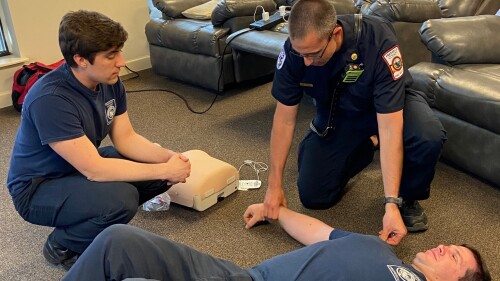It is no secret that the EMS industry is experiencing unprecedented turnover. The 2022 AAA Turnover report revealed a 31% voluntary turnover rate for full-time EMTs and a 26% voluntary turnover rate for full-time paramedics. Those turnover percentages imply that organizations will replace their full-time workforce every 3.5-4 years.
If turnover rates from the AAA report are compared to the National Registry of EMTs reports of EMTs and paramedics entering the workforce, it is evident that the EMS industry could be losing more EMS professionals than we are adding. While employee retention should always be a focus for organizations to support a healthy employee-focused culture, given the current state of our industry, successful employee retention initiatives could mean the difference between organizational sustainability and failure.
Many organizations use exit interviews as a standard practice when an employee voluntarily leaves. The goal is to identify ways to improve retention and reduce turnover by addressing the issues that led to the employee’s departure, but is that working? We are seeing unprecedented turnover, and a decade’s worth of exit interviews seem to be doing little to slow the exit from our industry. What if we were to flip the script, and instead focus on those employees that stay? Read on!
What is a stay interview?
Stay interviews are a relatively new approach to employee engagement that is gaining popularity. A stay interview is an interview between an employer and an employee designed to identify what makes the employee stay with the company and what the employer can do to keep the employee engaged and committed to the organization. Gathering this information and understanding may provide opportunities to enhance the things that keep people with your organization.
How stay interviews work
Stay interviews are typically conducted regularly, such as annually or bi-annually, to gather employee feedback and improve employee engagement and satisfaction. These conversations are not one and done; they should be one of several conversations that empower supervisors and managers to show employee support.
Stay interviews are typically conducted by a supervisor or a manager, preferably whoever should have a connection with the employee being interviewed. They are not intended to be dumped on HR because the supervisors are too busy. If the supervisors are “too busy” to connect with their employees, management should take that opportunity to evaluate the supervisors’ job tasks and duties.
Stay interviews are designed to be a two-way conversation, not just another survey, focusing on the employee’s current job satisfaction, future career goals and areas where leadership can better support the employee’s success. They aim to gain insight into the employee’s needs, wants and expectations, and are a way for leaders to use the information to develop strategies for employee retention, and are not intended for discussing job performance or improvement plans.
Benefits of stay interviews
Stay interviews offer several benefits to both employees and employers. A 2021 Gallup survey revealed that nearly half of U.S. workers (48%) were actively looking for new job opportunities, but 52% of those who were voluntarily exiting stated that their managers could have done something to prevent them from leaving.
Stay interviews help employees feel valued, respected and supported, improving their engagement and motivation.
For employers, stay interviews offer valuable insights into employee engagement and retention. By identifying the factors that keep employees engaged and committed to the organization, employers can develop strategies to improve employee retention and reduce turnover.
Stay interviews also allow employers to identify potential problems before they escalate, allowing them to take proactive steps to address issues before they become major problems.
These crucial touchpoints with employees could be the first step in improving organizational trust, and they let team members know they are being heard.
WATCH | Dealing with defensive employees
When we work with someone who is defensive, it causes you as the leader to feel frustration and tension, and just makes communicating with that person a challenge. Listen and watch as Chris Cebollero discusses how best to deal with defensive people.
How to get started with stay interviews
To implement stay interviews, leaders should collaboratively establish clear goals and purpose for the interviews. This might include improving employee retention, identifying areas for improvement in employee engagement or addressing specific employee concerns. Leaders should also plan how the interviews will be recorded and whether capturing specific data points will benefit future retention planning.
Once the goals and purpose of the interviews have been established, employers should develop a list of questions to ask employees during the interview. These questions should be open-ended and designed to elicit honest, detailed employee responses. Some sample questions might include the following:
- What do most look forward to when traveling to work each day?
- What keeps you working here?
- What motivates you to come to work each day?
- How do you like to be recognized?
- Are there current conditions that are tempting you to leave? If so, what are they?
- Are there things you would like to learn while working with us?
- What talents are not being used in your current role?
- What can I do, as your supervisor, to better support you?
- What can we do to improve your job satisfaction and engagement?
After the questions have been developed, employers should schedule individual interviews with employees and conduct them in a private and confidential setting. Employers should also be prepared to listen actively to employees’ responses, take notes, and follow up on any issues or concerns raised during the interview.
Stay interviews are a powerful tool for improving employee engagement, retention and job satisfaction. If you’re interested in conducting stay interviews in your organization, establish a clear goal and purpose, develop a list of open-ended questions, and schedule individual interviews with employees. With some planning and effort, stay interviews can help build a more engaged, motivated and committed workforce.
This article, originally published in September 2023, has been updated.














